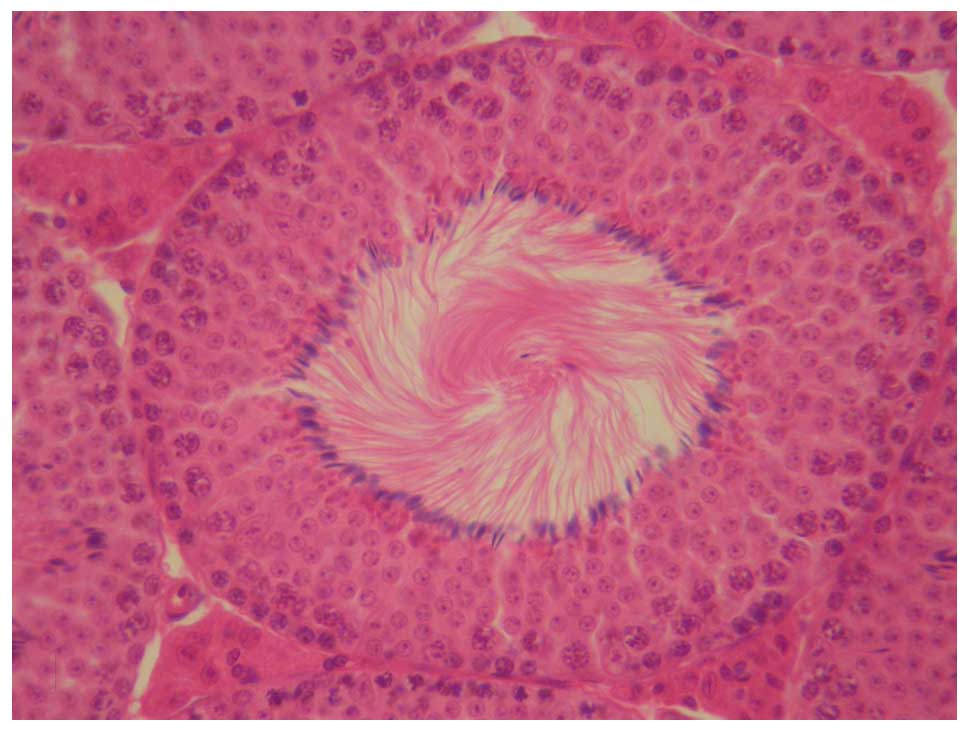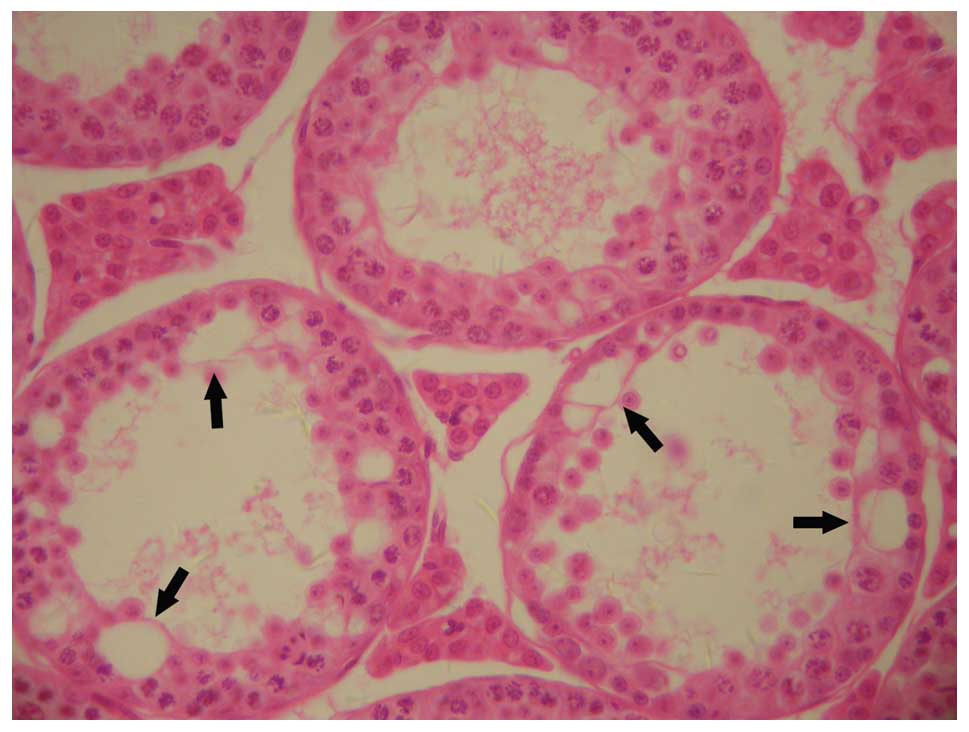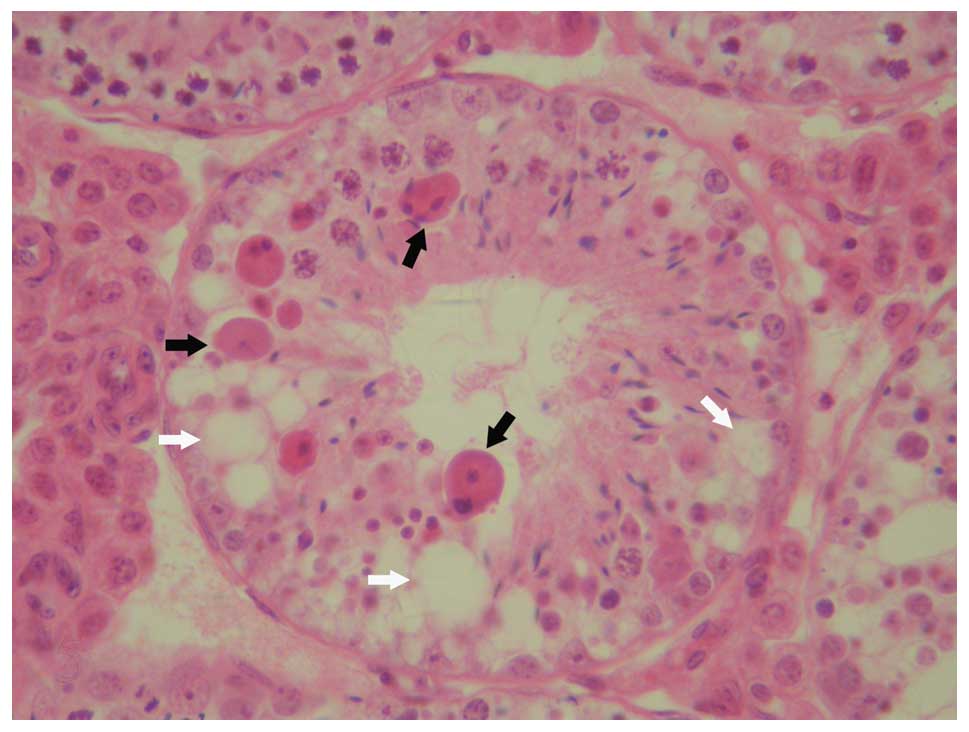|
1
|
Muczynski V, Cravedi JP, Lehraiki A, et
al: Effect of mono-(2-ethylhexyl) phthalate on human and mouse
fetal testis: In vitro and in vivo approaches. Toxicol Appl
Pharmacol. 261:97–104. 2012. View Article : Google Scholar : PubMed/NCBI
|
|
2
|
Nagano M, Patrizio P and Brinster RL:
Long-term survival of human spermatogonial stem cells in mouse
testes. Fertil Steril. 78:1225–1233. 2002. View Article : Google Scholar : PubMed/NCBI
|
|
3
|
Beissbarth T, Borisevich I, Hörlein A, et
al: Analysis of CREM-dependent gene expression during mouse
spermatogenesis. Mol Cell Endocrinol. 212:29–39. 2003. View Article : Google Scholar : PubMed/NCBI
|
|
4
|
Merker HJ and Günther T: Testis damage
induced by zinc deficiency in rats. J Trace Elem Med Biol.
11:19–22. 1997. View Article : Google Scholar : PubMed/NCBI
|
|
5
|
Vernet N, Dennefeld C, Guillou F, Chambon
P, et al: Prepubertal testis development relies on retinoic acid
but not rexinoid receptors in Sertoli cells. EMBO J. 25:5816–5825.
2006. View Article : Google Scholar : PubMed/NCBI
|
|
6
|
Moffit JS, Bryant BH, Hall SJ and
Boekelheide K: Dose-dependent effects of sertoli cell toxicants
2,5-hexanedione, carbendazim, and mono-(2-ethylhexyl) phthalate in
adult rat testis. Toxicol Pathol. 35:719–727. 2007. View Article : Google Scholar : PubMed/NCBI
|
|
7
|
Nantel F, Monaco L, Foulkes NS, et al:
Spermiogenesis deficiency and germ-cell apoptosis in CREM-mutant
mice. Nature. 380:159–162. 1996. View
Article : Google Scholar : PubMed/NCBI
|
|
8
|
Shaha C, Tripathi R and Mishra DP: Male
germ cell apoptosis: regulation and biology. Philos Trans R Soc
Lond B Biol Sci. 365:1501–1515. 2010. View Article : Google Scholar : PubMed/NCBI
|
|
9
|
Shivanandappa T and Krishnakumari MK:
Hexachlorocyclohexane-induced testicular dysfunction in rats. Acta
Pharmacol Toxicol (Copenh). 52:12–17. 1983. View Article : Google Scholar : PubMed/NCBI
|
|
10
|
Johannisson R, Schulze W and Holstein AF:
Megalospermatocytes in the human testis exhibit asynapsis of
chromosomes. Andrologia. 35:146–151. 2003. View Article : Google Scholar : PubMed/NCBI
|
|
11
|
Carrell DT, De Jonge C and Lamb D: The
genetics of male infertility: a field of study whose time is now.
Arch Androl. 52:269–274. 2006. View Article : Google Scholar : PubMed/NCBI
|
|
12
|
Toshimori K, Ito C, Maekawa M, Toyama Y,
et al: Impairment of spermatogenesis leading to infertility. Anat
Sci Int. 79:101–111. 2004. View Article : Google Scholar
|
|
13
|
Elkis Y, Bel S, Lerer-Goldstein T, et al:
Testosterone deficiency accompanied by testicular and epididymal
abnormalities in TMF(−/−) mice. Mol Cell Endocrinol. 365:52–63.
2013.PubMed/NCBI
|
|
14
|
Watson ML, Zinn AR, Inoue N, et al:
Identification of morc (microrchidia), a mutation that results in
arrest of spermatogenesis at an early meiotic stage in the mouse.
Proc Natl Acad Sci USA. 95:14361–14366. 1998. View Article : Google Scholar : PubMed/NCBI
|
|
15
|
Singh SK and Chakravarty S:
Antispermatogenic and antifertility effects of
20,25-diazacholesterol dihydrochloride in mice. Reprod Toxicol.
17:37–44. 2003. View Article : Google Scholar : PubMed/NCBI
|
|
16
|
Mahmoud YI: Effect of extract of Hibiscus
on the ultrastructure of the testis in adult mice. Acta Histochem.
114:342–348. 2012. View Article : Google Scholar : PubMed/NCBI
|
|
17
|
Hentrich A, Wolter M, Szardening-Kirchner
C, et al: Reduced numbers of Sertoli, germ, and spermatogonial stem
cells in impaired spermatogenesis. Mod Pathol. 24:1380–1389. 2011.
View Article : Google Scholar : PubMed/NCBI
|
|
18
|
Liao W, Cai M, Chen J, et al: Hypobaric
hypoxia causes deleterious effects on spermatogenesis in rats.
Reproduction. 139:1031–1038. 2010. View Article : Google Scholar : PubMed/NCBI
|
|
19
|
Chuma S, Hosokawa M, Kitamura K, et al:
Tdrd1/Mtr-1, a tudor-related gene, is essential for male germ-cell
differentiation and nuage/germinal granule formation in mice. Proc
Natl Acad Sci USA. 103:15894–15899. 2006. View Article : Google Scholar : PubMed/NCBI
|
|
20
|
Paiardi C, Pasini ME, Gioria M and Berruti
G: Failure of acrosome formation and globozoospermia in the wobbler
mouse, a Vps54 spontaneous recessive mutant. Spermatogenesis.
1:52–62. 2011. View Article : Google Scholar : PubMed/NCBI
|
|
21
|
Seachrist DD, Johnson E, Magee C, et al:
Overexpression of follistatin in the mouse epididymis disrupts
fluid resorption and sperm transit in testicular excurrent ducts.
Biol Reprod. 87:412012. View Article : Google Scholar : PubMed/NCBI
|














